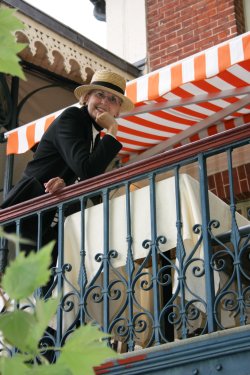|
|
|
|
|
Discussion Questions for Book Groups and Classes
|
|
|
|
|
|
|
|
|
|
|
|
|

|
|
|
|
Courtesy Betty van Wijhe, 2006 |
|
|
|
Here are some questions that I hope will stir some discussion: 1. How do the separate models' plots act upon the progress of the painting and enlighten a single common theme? Which of the male models is your favorite? And of the female models? Why does each hold a place in your affections? 2. In what ways do the models' stories and lives depict what was then thought of as la vie moderne? Considering the characters who are not models, which ones contribute to the concept of la vie moderne? How do these characters give life and fullness to the novel? 3. Throughout the novel there are social contrasts--rich and poor, suffering and insouciance, past and present, city and country, war and peace, friends and enemies. Speculate on how these serve to make the novel transcend the period depicted. 4. Besides Renoir, how do other characters explore the issue of creative expression? In whom is this yearning most deeply felt? What effect does the gathering of these people have on each other? 5. Consider the character of Gustave in terms of personality, strengths, weaknesses, motives. Auguste remarks that he and Gustave both have ambiguities and double roles in their natures and lives. What might he have been referring to and why is it ironic? How do these alternate roles play out in the course of the novel? How are these two characters opposites and how are they similar? 6. When the models are finished posing for the last time, Jules quotes from the poem "Fra Lippo Lippi" by Robert Browning. How does the poem reflect the narrative? The poem's next two lines are: "God uses us to help each other so,/Lending our minds out." Does this change what you've said in answer to the first part of this question? 7. Why was loving her neighbor as herself an immediate natural response one time in Alphonsine's life, and a complicated thing another time? That is, what resided in her thought which made it complicated? What are the stakes for her in both circumstances? What gift does Alphonsine have in the end? How has she changed, and by what means? 8. Do you see or sense any change in Renoir from beginning to end? What did the painting give him in terms of his art as well as in other ways? 9. After the last luncheon, Renoir is looking at the five women who modeled for the painting. He says that all of them are brave. How does his assessment apply to each one individually? How does this remark relate to his other remark that he paints women as he would paint carrots? 10. In what way does Luncheon of the Boating Party signal any healing of France for Alphonsine? For anyone? Or do you disagree, and it is not a signal of healing? Renoir wrote in his notebook, "When art becomes a useless thing, it is the beginning of the end." How does this relate to healing? To our time? 11. In The Marriage Feast at Cana, Veronese painted an opulent midday feast for thirty-five guests plus servants, musicians, and onlookers. In Luncheon on the Grass (Déjeuner sur l'herbe), Manet depicted a nude woman and three clothed men having a picnic. Caillebotte painted a luncheon at home with his mother and brother absorbed in their food at a vast table, and another painting with just empty glasses and empty chairs. In The Potato Eaters, van Gogh gathered five peasants around a platter of potatoes in a dark cottage. Pieter Bruegel the Elder also painted peasants in The Wedding Feast. And Renoir painted nine men and five women after a summer meal on a sunny terrace. If you were a painter, how would you treat the motif of a midday meal? What occasion or situation, if any, would you be celebrating? In what setting? What would the menu be? How would the lines of interaction cross? 12. In what ways, if any, did the novel surprise you? How do you react to a novel that incorporates real and well known people as characters? Did anything in the novel affect the way you had previously thought about Renoir? Impressionism? Impressionists? Paris? The French people? French culture? 13. What new insights about painting and the purpose and joy of art does the novel give you? Looking at all of the paintings by Renoir on the website, which one is your favorite? Why? Which one is most moving? Renoir said, "Everyone sings his own song if he has a voice. One has to paint the painting of his time." What ought to be in the paintings or songs of our time? You might explore the Renoir Quotes page and the Teacher's Guide for more ideas for discussion. |
|